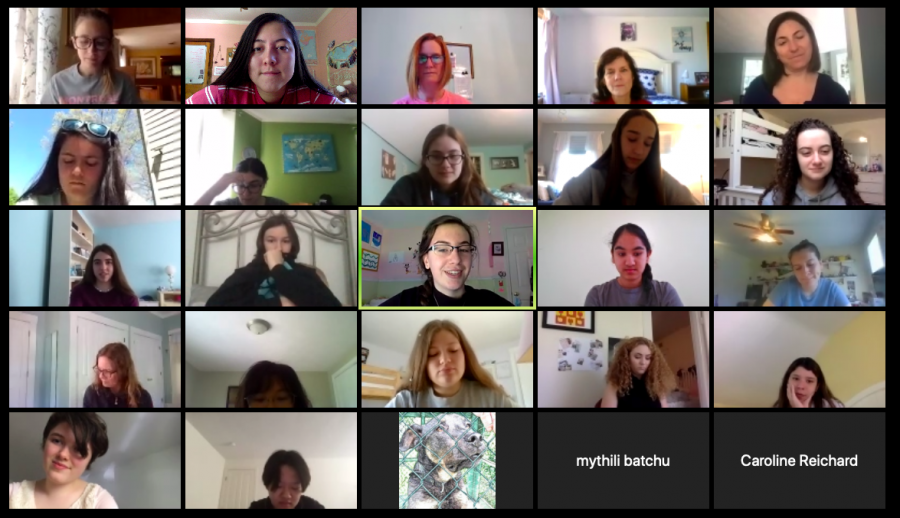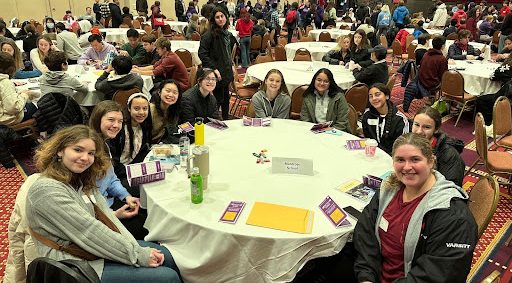Headaches Over Zoom: Fact or Fiction?
Juniors listen to a classmate give a Stud Gov Class Rep speech during M-Block two weeks ago. Many students question whether or not M-Blocks should occur during Enrichment, a key break time from screens.
With two weeks left of classes plus one for finals, it’s time Montrose took a look back at our online learning experience. It’s impressive how much we learned in these two months. Somehow, our teachers carried us through to APs and we’re on our way to our final experiences. Zoom and online communications are bringing us to the end of the year. But one lingering question remains: does online learning also bring students and teachers side effects such as headaches?
In a recent survey to students, about 41% of respondents said they “often” get headaches from spending so much time online. Approximately 38% “sometimes” experience headaches. This leaves only about 21% “rarely” getting headaches from their online learning. This might appear rather alarming. If the survey accurately represents the student body, then only one-fifth of the Montrose student population escaped Zoom with minimal head pain?
Perhaps not. The majority of survey respondents also said that their headaches have decreased since we decreased the number of classes per week. Those whose headaches haven’t decreased either never got headaches, or they are in the 27% who still experience headaches.
Thus, there are still some areas for growth. Middle School English teacher Mrs. Roberts said, “I don’t know that the decrease in live classes has really helped much. The computer has become my lifeline to everything at school, so even if I am not zooming, I’m still staring into a screen preparing to zoom the next time.” Many students agree that they’re still staring at a screen just as much because they’re substituting online work in place of zoom classes. Gabriella Bachiochi ‘21 said, “Usually if we don’t have a zoom class, teachers still assign online homework.” And she suggested something that could help. She said: “If possible, teachers could assign us homework that’s more hands-on.” Gabriella Dansereau ‘26 said that the online experience “could be improved by students having less actual zoom classes and instead of being asked to complete written or off-the-screen assignments during that class time.”
Josie Marcucci ‘25 offered a solution that would maintain the regular check-ins of Zoom, but which would also reduce screen time. She said, “Maybe we could still Zoom because those are good for questions and teaching, but make them shorter.” I’ve had a few classes in which a teacher checked in with the class for fifteen minutes, but then we worked independently for the rest of the time. This did seem to reduce the brain drain Zoom notoriously causes.
Maybe fewer Zoom meetings hasn’t lessened screen time, yet a majority of students noted that Zoom has caused their headaches. Mrs. Whitlock mentioned a factor which may explain why: “I find Zoom classes drain my brain…I think the reason is because of the multitasking strain.” She added, “The teacher is focused on lesson goals, trying to see who has participated, who is tuned out, finding ways to engage, sharing screens with movie clips, using the whiteboard, watching and adding to the chat.”
So is the real problem the multitasking that Zoom requires, and not the act of staring at a screen? The New York Times piece “The Tech Headaches of Working from Home and How to Remedy Them” by Brian Chen explored this issue. Chen cited Jason Fried, author of “Remote: Office Not Required” and founder of a software company, who said that the excess of gadgets is the main cause of frustration with working from home. The many gadgets theory suggests that the real issue lies in multitasking. Fried suggests that home workers limit their apparatus to a laptop, comfortable chair, lamp, and noise-canceling headphones. He also suggests that they avoid backaches by periodically placing their device on a bookcase and standing up.
Several students mentioned that blue light glasses have decreased headaches, while Academic Dean Ms. White said, “In the beginning, I had a headache every day. I ordered blue light glasses, which have made a huge difference.” These experiences suggest that it is, in fact, the screen time that causes the headaches, as screens emit blue light on Zoom or not.
Ultimately, I or any other student may not crack the theory of headache origins. But online learning has caused many students and teachers to get creative with how to stave off headaches, back pain, and more. Some online life hacks: “Stay hydrated,” said Ava Russo ‘23. “Reposition your laptop…or change the height of your chair to avoid neck tension.” Caroline Reichard ‘21 advised, “Sleep for 7-8 hours.” Mrs. Silveyra echoed the success of blue light glasses. Maevis Fahey ‘21 said, “The breaks in between classes are a big help because we all need a brain break.” So if headaches or anything else plagues you, drink some water, buy some blue light lenses, and remember to use your breaks to leave your screen!
Anna Sheehan ’21, Faith Editor
21asheehan@montroseschool.org















